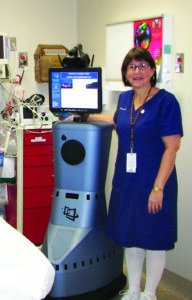Cherokee Indian Hospital Emergency Department has a new “employee” to serve the community. Its name is De Da Nu Weski, meaning healer, and it’s a Telestroke Robot.

Victoria Harlan, RN, BSN, Cherokee Indian Hospital ER manager, poses with the Telestroke Robot.
(CIH photo)
Over the past year (2012), 37 patients at Cherokee Indian Hospital (CIH) were diagnosed with acute Cerebral Vascular Accident (CVA) or stroke, 32 were diagnosed with stroke-like symptoms and 18 patients were diagnosed with Bells Palsy.
A CVA or stroke occurs when blood stops flowing to the brain. The blood vessels that carry blood and oxygen to the brain are clogged or they have burst. When that happens part of the brain starts to die. It can kill brain cells that control speaking, moving, thinking and breathing.
To address these issues, CIH has partnered with Mission Hospital to provide stroke and neurologists services to people in the Cherokee community through tele-health and the Telestroke Robot is the newest project. Telestroke combines computer workstations used by Mission Hospital physicians with an endpoint remote robot stationed at CIH.
The physicians at Mission have the ability to navigate the robot, zooming in, focusing on the patient. You can see the doctor’s face projected onto the robot just as they can see you and everything in the room. You can talk to the doctor privately and they can view tests such as CT scans or laboratory test results.
The benefits of having Telestroke available at Cherokee Indian Hospital is early detection and monitoring, earlier patient intervention, better communication, easy access to specialty care from CIH hospital to Mission and more control over individual care.
“We hope you never have to meet De Da Nu Weski, but if you do know that you are served by two exceptional teams, the ER staff at Cherokee Indian Hospital and Mission Hospital,” CIH officials said.
– Cherokee Indian Hospital





